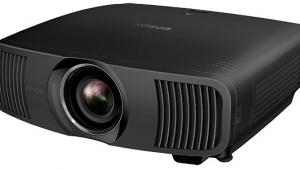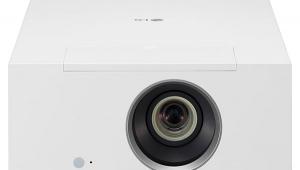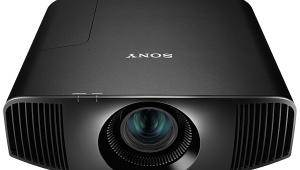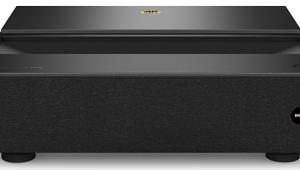Sony MP-CL1 Laser Projector
PRICE $350
AT A GLANCE
Plus
Compact form factor
Auto focus
Acts as phone charger
Minus
No way to fine-tune focus
Some laser sparkle
Overly warm color balance
Only two hours on a
battery charge
THE VERDICT
Sony’s super-cool laser projector delivers an acceptable image and easy setup when compactness and portability are paramount.
Instead of a DLP chip and an LED light source, Sony’s MP-CL1 uses a laser to literally scan its 1920 x 720-resolution image. The laser diode (which is spec’d for 2,000 hours but lasts up to 10,000, Sony says—versus 20,000 to 30,000 for LED) is directed into something called a MEMS mirror. The mirror physically moves to precisely control the beam and create the image. What? You’ve never heard of MEMS? It stands for “micro electric mechanical system,” and it describes a chip that’s fabricated like a semiconductor but includes both electrical and mechanical elements to perform a specific task. Sound familiar? That’s right: DLP’s Digital Micromirror Device (DMD) is also a MEMS.

An interesting advantage to Sony’s laser approach is the ability for each pixel to retain its sharpness on the screen with no need to mechanically focus a lens. It’s an odd experience to move a projector in or out and watch the image zoom accordingly but with no need to adjust focus. The MP-CL1 will even keep the focus uniform across an image cast on an undulating wall, or if part of the picture sits atop a bump-out or other obstacle. No focus control is even provided.

The MP-CL1 is impressively solid, with a sleek black metal case about the size of a standard iPhone. It comes with a USB-to-micro-USB charging cable (the unit works two hours on a charge), an HDMI-to-mini-HDMI adapter for the projector’s mini-HDMI/MHL input, and a plastic kickstand that casts the image slightly upward for coffee-table placement. (The tripod insert found with the other projectors is absent here; I had to tape the Sony to my tripod. Also absent is a carry bag.) Along with HDMI, you can connect with Wi-Fi mirroring from Android sources. There’s also a regular USB port that will charge your phone in a pinch from the MP-CL1’s battery. The projector accepts signals up to 1080p.
Along one side of the MP-CL1 is an on/off button and a little swivel/plunger control used to access the menu, navigate up/down, and then select. The menu is surprisingly extensive and includes controls for vertical and horizontal keystone correction, contrast and brightness, and color saturation and hue. An alignment menu is used to periodically reconverge the laser’s red, green, and blue primaries.
I was wowed by the Sony’s technology, form factor, and user interface, and it threw a respectable image, though not without some noticeable flaws. First, the good: Although it has only 37 lumens of light output, it’s rated to cast pictures from 40 to 120 inches, so my 65-inch image target was well within its range. The 2.2 ft-L or so that I measured at that size, while still meager, was a bit brighter and had more perceived punch than the Magnasonic’s image. This was thanks in part to the Sony’s ability to achieve a much deeper black than any of the DLP models I tested (see the accompanying chart). It had, by far, the best measured contrast ratio of any of the four projectors at any image size, though its lack of brightness was still limiting, even at 65 inches. Ultimately, I found that pushing the projector in for a 50-inch image gave it satisfying brightness, though that shrunk to 30 inches to get to my 12 ft-L ideal target.
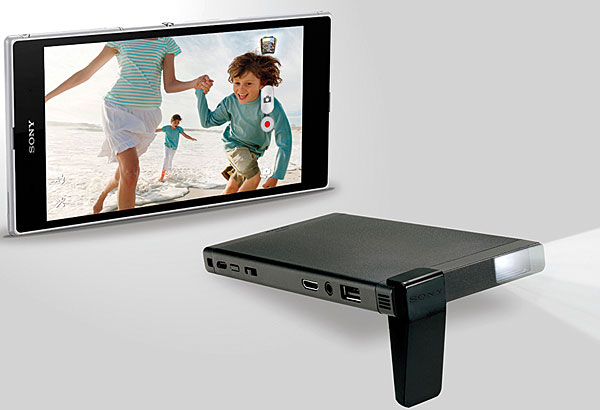
At any image size, I was troubled by a color balance that leaned too far red in the dark areas of the picture. This was quickly apparent in the already golden-red landscape in the opening scenes of The Martian, as well as in Rogue Nation, where it made the dark wood of a record-store listening booth and the paneled walls of a Senate hearing room take on a reddish hue instead of the natural dark brown walnut seen on a proper display. This was mitigated by reducing the color saturation a touch, but the hue control wasn’t much help. And despite the projector’s 720p resolution, that last bit of sharpness was always missing, even from small images, and it made me yearn for a lens adjustment for fine-tuning. Finally, the nature of laser projection is that you get pearlescence in lighter areas of the image that becomes more apparent with camera movement. The MP-CL1 has technology to tame this so-called laser sparkle, though I did spot it occasionally. It wasn’t particularly bothersome.
Again, it’s only fair to lower the expectations for a $350 projector that is so small and so remarkably high-tech for its price, and whose intended purpose is really just to deliver mobility and a useful image when you need it. Most users will likely be amazed by the Sony and what it can do and will readily forgive its faults, if they even notice them. And while you’ll find alternatives at its price that might deliver a brighter and perhaps even sharper image, they most certainly won’t have the incredible portability or cool factor of the MP-CL1.
Specs
Dimensions (WxHxD, Inches): 5.9 x 0.5 x 3.1
Weight (Pounds): 0.46
Resolution: 1920 x 720
Brightness: 37 lumens
Inputs: HDMI Ver. 1.4b with MHL 2.2, Micro USB (power/charging)
Outputs: 3.5mm stereo analog audio, USB (for charging external devices)
Miscellaneous: Recommended image size (inches), 40-120; throw distance (feet), 3.77 at 40-inch screen size
Company Info
Sony
(877) 865-7669
sony.com








